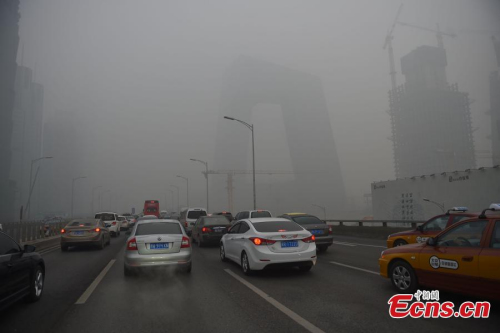
Vehicles run amid heavy smog and thick fog in Beijing, Dec. 25, 2015. (Photo: China News Service/Jin Shuo)
Beijing lawmakers are considering measures to keep half the city's cars off the roads during the coldest months of the year, when coal-fired municipal heating tends to cause a lot of smog.
Delegates at Thursday and Friday's Two Sessions, the plenary sessions of the People's Congress and Political Consultative Conference, hope that cutting vehicle emissions can help in times of peak air pollution.
The measures would be applied during the "winter heating season" from around mid-November to mid-March, said Li Shixiang, vice mayor of Beijing.
Vehicle emissions account for 31 percent of the city's smog sources, according to the Beijing Environmental Protection Bureau.
Current traffic rules, based on license plate numbers, take about a fifth of vehicles off the roads each weekday. Beijing enforces odd-even plate number restrictions during severe smog and also for big international events such as the 2008 Olympics and the APEC summit in 2014.
"Beijing wants to improve its smog warning mechanism and refine traffic restriction measures to make them more effective," said a spokesperson for the Beijing Municipal Transportation Commission, without specifying what measures would be used.
There are 5.6 million vehicles registered in Beijing.
Last month, local traffic authorities revealed that the capital is likely to trial a congestion charge for road users, prompting hot debate.
In response to the public misgivings, Li said no timetable had been set and promised no "abrupt" implementation of the rule.
Beijing has rolled out various policies to improve air quality, such as cutting back on coal use and phasing out outmoded vehicles.
According to a report delivered to the municipal legislature on Friday by Mayor Wang Anshun, the average density of PM2.5, airborne particles smaller than 2.5 microns in diameter, in Beijing last year declined by 15.8 percent compared with the level in 2012.
In the past five years, the city has cut coal use by nearly 14 million tonnes and weeded out 1.8 million outdated vehicles.
Beijing is aiming for a year-on-year drop of 5 percent in its average PM2.5 reading in 2016. The city government has promised to remove 200,000 high-emission vehicles from the roads and promote the use of clean energy in 400 villages this year.


















































